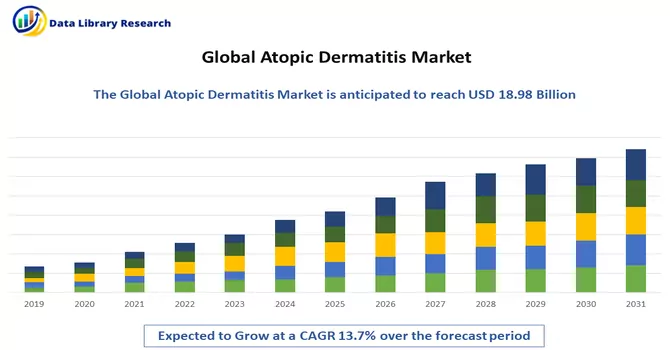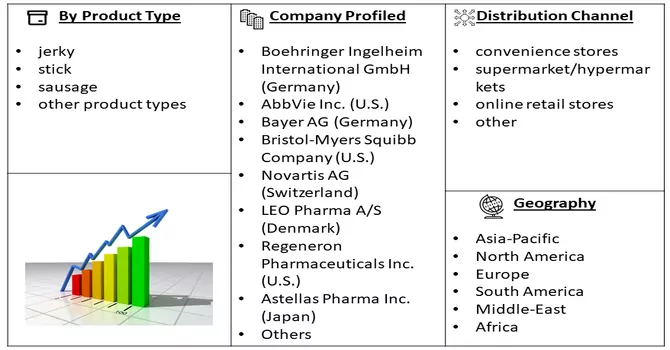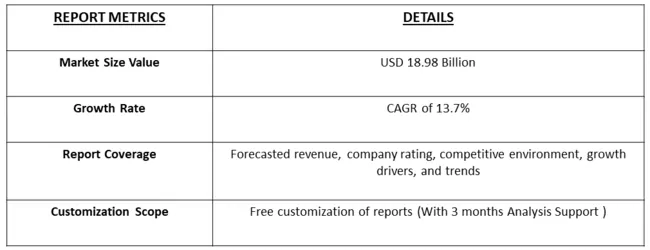The Global Atopic Dermatitis Market is currently valued at USD 18.98 Billion by 2023 and is expected to register a CAGR of 13.7% during the forecast period 2024 to 2031.

Get Complete Analysis Of The Report - Download Free Sample PDF
Atopic dermatitis (AD), commonly known as eczema, represents a prevalent and chronic inflammatory skin condition that significantly impacts the global healthcare market. The market overview of atopic dermatitis reflects a growing concern for effective and innovative treatment options, as the condition affects millions of individuals worldwide, transcending age groups. Pharmaceutical companies are increasingly investing in research and development to address the unmet medical needs of AD patients, leading to a surge in the introduction of novel therapeutics and topical formulations.
Additionally, the market witnesses a notable emphasis on patient-centric approaches, with a focus on enhancing the quality of life for those affected by atopic dermatitis. As awareness about the condition continues to rise, market dynamics are shaped by a demand for advanced therapies, coupled with a heightened emphasis on holistic management strategies, driving innovation and competition within the atopic dermatitis market.A pivotal growth-driving factor for the atopic dermatitis market is the increasing prevalence of the condition worldwide, propelling a surge in demand for advanced and effective treatment options. With a rising number of individuals affected by atopic dermatitis across diverse age groups, there is a growing need for innovative therapeutic interventions to address the substantial burden on healthcare systems. This escalating patient pool has spurred pharmaceutical companies to intensify research and development efforts, leading to the introduction of novel drugs, biologics, and targeted therapies. The continuous pursuit of groundbreaking solutions fueled by the expanding atopic dermatitis demographic not only stimulates market growth but also fosters a dynamic landscape where innovation, accessibility, and patient-centric approaches converge to shape the future of dermatological care.
Market segmentation: The Global Meat Snacks Market by Application and is segmented by product type (jerky, stick, sausage, and other product types), by distribution channel (convenience stores, supermarket/hypermarkets, online retail stores, and other distribution channel types), and by geography (North America, Europe, Asia-Pacific, South America, and Middle-East and Africa). The market size and forecasts are provided in terms of value (USD million) for the above segments.

For Detailed Market Segmentation - Download Free Sample PDF
The market trends in the atopic dermatitis market reveal a dynamic landscape shaped by continuous advancements in therapeutic options and a heightened focus on personalized treatment approaches. Biologic drugs, particularly monoclonal antibodies targeting specific immune pathways, have gained prominence, offering more targeted and effective solutions for moderate to severe cases. The integration of digital health technologies and telemedicine in the management of atopic dermatitis is on the rise, facilitating remote patient monitoring and personalized care. Furthermore, a surge in the development of topical treatments, including corticosteroids and calcineurin inhibitors, caters to the demand for convenient and localized solutions. Collaborative efforts between pharmaceutical companies and academic institutions are fostering innovative research, exploring new mechanisms of action and potential breakthroughs in atopic dermatitis treatment. Overall, the atopic dermatitis market trends reflect a dynamic pursuit of advancements that prioritize efficacy, safety, and patient-centric care.
Market Drivers:
The rising incidence of atopic dermatitis globally has created a substantial patient pool.
The escalating incidence of atopic dermatitis worldwide has resulted in a significant and expanding patient population, driving heightened attention and demand within the healthcare industry. This surge in cases has been particularly pronounced across diverse age groups, emphasizing the urgent need for effective management and treatment strategies. The increasing prevalence of atopic dermatitis not only underscores the substantial burden on healthcare systems but also serves as a crucial market driver, stimulating robust research and development initiatives to address the unmet medical needs of this growing demographic. As the global patient pool expands, pharmaceutical companies and healthcare stakeholders are propelled to innovate, invest, and collaborate in order to meet the rising demand for advanced therapeutic solutions and holistic care approaches for individuals grappling with atopic dermatitis.
The market is bolstered by a continuous stream of innovative drugs and therapies,
The atopic dermatitis market experiences sustained growth driven by a consistent influx of innovative drugs and therapies. This ongoing influx is characterized by advancements in treatment modalities, including the development of biologics, targeted immunomodulators, and novel topical formulations. Pharmaceutical companies' commitment to research and development endeavours, seeking to enhance the efficacy and safety of therapeutic options, fuels this continuous stream of innovation. As the market witnesses the introduction of cutting-edge solutions, ranging from personalized biologics to advanced topical treatments, the landscape becomes dynamic and responsive to the evolving needs of atopic dermatitis patients. This trend not only diversifies the available treatment arsenal but also positions the market as a hub for transformative and patient-centric approaches, fostering competition and further propelling advancements in the management of atopic dermatitis.
Market Restraints:
Several market restraints challenge the atopic dermatitis market, hindering its growth and development. Firstly, the high cost associated with some advanced treatment options, particularly biologics and certain targeted therapies, poses a significant barrier to widespread accessibility. Affordability issues can limit patient access to cutting-edge treatments, impacting the market's expansion. Secondly, regulatory hurdles and stringent approval processes for new drugs can lead to delays in bringing innovative therapies to the market, impeding swift advancements. Additionally, the lack of a universally accepted standard for assessing disease severity in clinical trials complicates the development and comparison of treatments. Moreover, the long-term safety profiles of certain medications remain a concern, affecting both patient and physician confidence in adopting these therapies. Finally, the absence of a definitive cure for atopic dermatitis underscores the chronic nature of the condition, necessitating ongoing management, and potentially limiting the market's growth in terms of achieving complete resolution for patients. These factors collectively contribute to the complex landscape of challenges faced by the atopic dermatitis market.
The COVID-19 pandemic has exerted a multifaceted impact on the atopic dermatitis market. On one hand, the increased focus on infectious diseases and the diversion of healthcare resources towards managing the pandemic has somewhat slowed down research and development efforts for new atopic dermatitis therapies. Moreover, disruptions in supply chains and logistical challenges have intermittently affected the production and distribution of existing treatments. On the other hand, the pandemic has heightened awareness about the importance of overall health, fostering a greater understanding of chronic conditions like atopic dermatitis. Telehealth and digital health solutions have gained prominence, offering alternative means of consultation and treatment monitoring for patients with atopic dermatitis. While the full extent of the pandemic's impact is still unfolding, these shifts underscore both challenges and opportunities within the atopic dermatitis market, as it adapts to the evolving dynamics of healthcare delivery in the context of a global health crisis.
Segmental Analysis:
Jerky Segment is Expected to Witness Significant Growth Over the Forecast Period
In the context of atopic dermatitis (AD), a chronic inflammatory skin condition, jerky, a popular dried and cured meat snack, has raised some concerns. Certain ingredients and additives in jerky, such as preservatives, flavourings, and spices, could potentially trigger or exacerbate AD symptoms in individuals with sensitivities. Histamine and other biogenic amines found in aged or improperly processed meats, as well as the high salt content in some products, may contribute to skin inflammation and irritation. However, "clean label" jerky made from high-quality, minimally processed meats without artificial additives or preservatives may be better tolerated by those with sensitive skin conditions. It is advisable for individuals with AD to monitor their diet, including jerky consumption, and consult with healthcare professionals to identify and manage potential triggers.
Supermarket/Hypermarkets Segment is Expected to Witness Significant Growth Over the Forecast Period
Supermarkets and hypermarkets play a crucial role in catering to individuals with atopic dermatitis (AD), a condition that requires careful selection of products to avoid triggering skin irritations. These retail outlets can stock a variety of hypoallergenic skincare products, fragrance-free detergents, and suitable foods, providing clear labeling and information on ingredients to help AD sufferers make informed choices. Additionally, offering online shopping and delivery services can further support customers with AD, ensuring access to necessary products while accommodating their specific needs. Understanding and addressing the unique requirements of this segment can enhance customer satisfaction and loyalty, ultimately benefiting both the retailer and the AD community. Thus, the segment is expected to witness significant growth over the forecast period.
North America Region is Expected to Witness Significant Growth Over the Forecast Period
North America represents a significant market for atopic dermatitis (AD) treatments and products, given the region's high prevalence of the condition and advanced healthcare infrastructure. AD, a chronic inflammatory skin disorder, affects millions of individuals in North America, leading to significant healthcare costs and quality-of-life issues. The region is characterized by a high level of research and development in the field of dermatology, leading to the development of innovative treatments and therapies for AD. Additionally, North America is home to a large number of pharmaceutical and biotechnology companies that are actively engaged in developing new AD treatments. The region's strong regulatory framework and healthcare standards ensure that AD treatments meet stringent safety and efficacy requirements. Overall, North America is a key market for AD treatments, with a growing focus on providing effective and personalized care for individuals suffering from this chronic skin condition.

Get Complete Analysis Of The Report - Download Free Sample PDF
The analyzed market exhibits a high degree of fragmentation, primarily attributable to the presence of numerous players operating on both a global and regional scale. The competitive landscape is characterized by a diverse array of companies, each contributing to the overall market dynamics. This fragmentation arises from the existence of specialized solution providers, established industry players, and emerging entrants, all vying for market share. The diversity in market participants is underscored by the adoption of various strategies aimed at expanding the company presence. On a global scale, companies within the studied market are strategically positioning themselves through aggressive expansion initiatives. This often involves entering new geographical regions, targeting untapped markets, and establishing a robust global footprint. The pursuit of global expansion is driven by the recognition of diverse market opportunities and the desire to capitalize on emerging trends and demands across different regions. Simultaneously, at the regional level, companies are tailoring their approaches to align with local market dynamics. Regional players are leveraging their understanding of specific market nuances, regulatory environments, and consumer preferences to gain a competitive edge. This regional focus allows companies to cater to the unique needs of local clientele, fostering stronger market penetration. To navigate the complexities of the fragmented market, companies are implementing a range of strategies. These strategies include investments in research and development to stay at the forefront of technological advancements, mergers and acquisitions to consolidate market share, strategic partnerships for synergies, and innovation to differentiate products and services. The adoption of such multifaceted strategies reflects the competitive nature of the market, with participants continually seeking avenues for growth and sustainability. In essence, the high fragmentation in the studied market not only signifies the diversity of players but also underscores the dynamism and competitiveness that drive ongoing strategic manoeuvres. As companies explore various avenues for expansion, the market continues to evolve, presenting both challenges and opportunities for industry stakeholders.
Some of the market players working in this segment are:
Recent Development:
1) In October 2022, Leo Pharma initiated a comprehensive awareness campaign aimed at highlighting the impact of atopic dermatitis within diverse cultural contexts. This initiative showcased the personal journeys of four individuals residing in France, Italy, Germany, and Spain, each navigating life with the challenges of chronic skin disease. The campaign, driven by Leo Pharma, sought to raise awareness on a global scale, emphasizing the varied experiences and cultural nuances associated with atopic dermatitis.
2) In June 2022, Sanofi achieved approval from the U.S. Food and Drug Administration (USFDA) for Dupixent (dupilumab) for the treatment of moderate-to-severe atopic dermatitis in children aged 6 months to 5 years. This approval is particularly relevant for cases where the disease is not effectively managed with topical prescription therapies or when the use of such therapies is deemed impractical. Sanofi's successful regulatory milestone expands the therapeutic options available for young patients grappling with atopic dermatitis, addressing an unmet medical need and contributing to advancements in pediatric dermatological care.
Q1. What was the Atopic Dermatitis Market size in 2023?
As per Data Library Research the Atopic Dermatitis Market is currently valued at USD 18.98 Billion by 2023.
Q2. At what CAGR is the market projected to grow within the forecast period?
Atopic Dermatitis Market is expected to register a CAGR of 13.7% during the forecast period.
Q3. What are the factors on which the Atopic Dermatitis market research is based on?
By Application, By Product, By Distribution Channel and Geography are the factors on which the Atopic Dermatitis market research is based
Q4. Which region has the largest share of the Atopic Dermatitis market? What are the largest region's market size and growth rate?
North America has the largest share of the market. For detailed insights on the largest region's market size and growth rate request a sample here.
Data Library Research are conducted by industry experts who offer insight on industry structure, market segmentations technology assessment and competitive landscape (CL), and penetration, as well as on emerging trends. Their analysis is based on primary interviews (~ 80%) and secondary research (~ 20%) as well as years of professional expertise in their respective industries. Adding to this, by analysing historical trends and current market positions, our analysts predict where the market will be headed for the next five years. Furthermore, the varying trends of segment & categories geographically presented are also studied and the estimated based on the primary & secondary research.
In this particular report from the supply side Data Library Research has conducted primary surveys (interviews) with the key level executives (VP, CEO’s, Marketing Director, Business Development Manager and SOFT) of the companies that active & prominent as well as the midsized organization
FIGURE 1: DLR RESEARH PROCESS

Extensive primary research was conducted to gain a deeper insight of the market and industry performance. The analysis is based on both primary and secondary research as well as years of professional expertise in the respective industries.
In addition to analysing current and historical trends, our analysts predict where the market is headed over the next five years.
It varies by segment for these categories geographically presented in the list of market tables. Speaking about this particular report we have conducted primary surveys (interviews) with the key level executives (VP, CEO’s, Marketing Director, Business Development Manager and many more) of the major players active in the market.
Secondary ResearchSecondary research was mainly used to collect and identify information useful for the extensive, technical, market-oriented, and Friend’s study of the Global Extra Neutral Alcohol. It was also used to obtain key information about major players, market classification and segmentation according to the industry trends, geographical markets, and developments related to the market and technology perspectives. For this study, analysts have gathered information from various credible sources, such as annual reports, sec filings, journals, white papers, SOFT presentations, and company web sites.
Market Size EstimationBoth, top-down and bottom-up approaches were used to estimate and validate the size of the Global market and to estimate the size of various other dependent submarkets in the overall Extra Neutral Alcohol. The key players in the market were identified through secondary research and their market contributions in the respective geographies were determined through primary and secondary research.
Forecast Model
